Writing late in the evening is very… peaceful. With the routine of the day put away, within this tranquil rural setting, there is only the faint whirl of a computer fan and the clicking of the keyboard to be heard. You’d think with all of this going for me, my writing would be better. Oh, well…
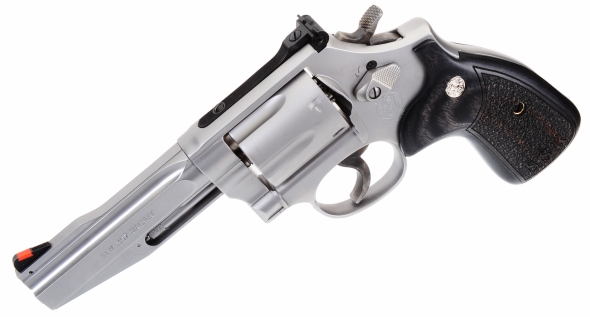
Back in the early seventies, I was looking for a reliable 1911 with popular modifications of the day incorporated, so I skipped the Government Model and bought a Colt National Match Gold Cup. A recoil spring change to let it cycle with full tilt loads without beating itself to death and I was all set; great accuracy, great trigger and adjustable sights of a type I still appreciate. The S&W 686-6 Pro Series Stock Service Revolver represents a similar choice; a 357 Magnum revolver, configured for Stock Service Revolver competition with features that make it an excellent defensive handgun.
The S&W Model 686 SSR has been with us only since 2010. However, at its foundation is the 1980 S&W Model 686 Distinguished Combat Magnum. Stronger than the K frame Model 66, the Model 686 was designed to take routine pounding from 357 Magnum ammunition. Six design iterations separate the original Distinguished Combat Magnum from the current S&W 686-6 Pro Series Stock Service revolver, which makes the S&W Model 686 SSR a time and tested refinement.
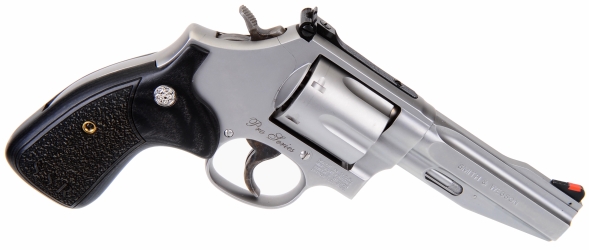
Highlighted features…
|
Model – S&W Model 686 SSR |
|
| Company | Smith & Wesson |
| Point of Origin | Springfield MA |
| SKU # | 178012 |
| Type of Action | DA/SA Revolver |
| Caliber | 357 Magnum / 38 Special +P |
| Capacity | 6 |
| Barrel Length | 4″ |
| Hardware | Stainless Steel |
| Finish | Matte |
| Rifling Twist Rate | 1:18.75″ |
| Grips | Hardwood Laminate |
| Front Sight | Ramped – Interchangeable |
| Rear Sight | Adjustable – Notched |
| Weight of Firearm | 38.3 Oz. |
| Overall Length | 9.75″ |
| Overall Height | 5.9″ |
| Width | 1.562″ |
| Key Lock | Yes |
| CA Certified | Yes |
| MA Certified | Yes |
| MSRP | $999 |
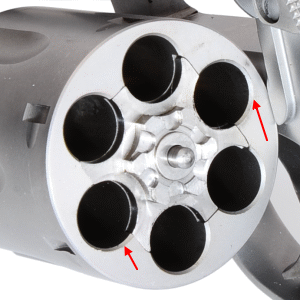
Sometimes enhancements come in the form of small but meaningful touches. Above, the feature is listed as “chamfered charge holes”, which essentially means a 45° cutter puts a chafer at the entrance to each chamber that speeds single and speed loader, loading. Not a minor features as not fumbling when reloading is a very good thing.
The model 686 SSR has a “custom barrel with recessed crown”. The recess depth is 0.040″ and the angle of the crown is 11°. The recess protects the crown and the crown deflects the minute powder, brass and bullet ejecta away from the base of the exiting bullet. If there are nicks at a firearm’s muzzle, or if the crown if cut off-perpendicular to the bore, the approximately 500 psi of muzzle pressure hitting the base of the bullet could be destabilizing and cause a loss of precision.

A little better picture of the business end of the Model 686 SSR that shows the recessed crown, the roll pinned and easy to change front sight and the slab sided 4″ barrel and angular full length shroud. The treatment assures that the revolver at 38.3 Oz. will be inside the IDPA maximum unloaded weight limit of 43.0 Oz., it gets weight off the nose of the revolver to make it quick handling and fast on target, while still providing a full 4″ of barrel length and ejector rod protection.
Bossed mainspring – Generally, as a standard mainspring is deflected it builds resistance/force in a linear fashion and proportional to the rotation of the hammer. Consequently, the closer the trigger gets to sear release, the heavier the resistance. Consequently, the pull beings light and then it builds to pine board snapping resistance just before hammer release. Changing to a lighter spring eases the effort at the end of the pull stroke, but also diminishes strike force and ignition reliability. Milling a spring to a tapered thickness juggles resistance curves a bit, but the result is essentially the same.

The boss spring places a tapered raised rib down the center of the flat spring, giving it a variable rate which makes the spring a little heavier than a conventional spring at early deflection, but building less as the spring deflects and nearly eliminating trigger stack up. A range of spring rates is available for folks who like to fine tune. For folks who like to research, there is patent information. As a side note the original Model 686 was a square butt frame, the Model 686 SSR is round butt, with grip profiles controlling hand fit and positioning.

Grasping the SSR’s grip places the hand naturally in a high hold and, for me at lease, when I bring the sights up they are in nearly perfect vertical alignment rather than offset high or low and requiring a good deal of correction. Checking grip to bore centerline interior angles with an inexpensive Goniometer, the front of the grip checks a tight 95º to 96º and the back something on the order of 101º to 102º. It is not unlike grabbing a Bisley target style grip.
More general observations…
Setting aside the issue of competition, because under my ownership the Model 686 SSR would not see competition, this S&W makes a heck of a trail gun and an excellent companion gun during hunting season. I am sure this revolver could be used for handgun hunting, however, I do not personally deer hunt with the 357 Magnum or shorter length barrel revolvers of any caliber.
The 686 SSR is narrow in a holster. The cylinder diameter, the thickest part of the revolver is only 1.562″, measured not nominal, still leaving plenty of meat in the cylinder walls, outer and adjacent.

The subject gun was put together well. The cylinder was tight and the cylinder to barrel gap measured 0.007″. Running a match range rod down the barrel, it cleared all of the chambers without bump or nudge cheating so timing was excellent. The finish was very nice… uniform fine beaded finish.
Trigger pull was a little heavy, but without the stacking, so it was relatively easy to shoot with accuracy single or double action. Single action pull checked 4 lbs 9 oz, double action just over 12 lbs. There are many ways to easily and inexpensively bring this down to 3 lbs single action and 8 lbs double action while retaining reliable ignition, but they beyond the scope of this project.
Oh, yes, with ammo…
The beauty of the 357 magnum and subordinate 38 Special ammunition revolver is in its flexibility of application. Twenty one manufacturers combine to produce eighty-eight type of 357 Magnum ammo. Eighteen manufacturers combine to produce ninety-nine types of 38 Special ammo. Why is that of consequence? Only because you would have to work triple hard to not find ammo for this gun.
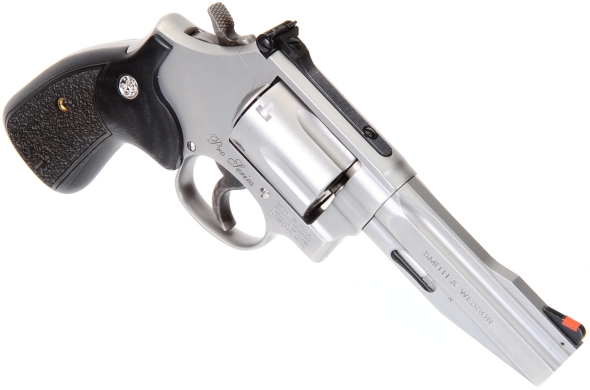
A few types of ammo were selected to get baseline performance of the S&W Model 686 SSR, some for target practice, some for self defense and some is actually labeled for deer size game hunting. The results look something like this:
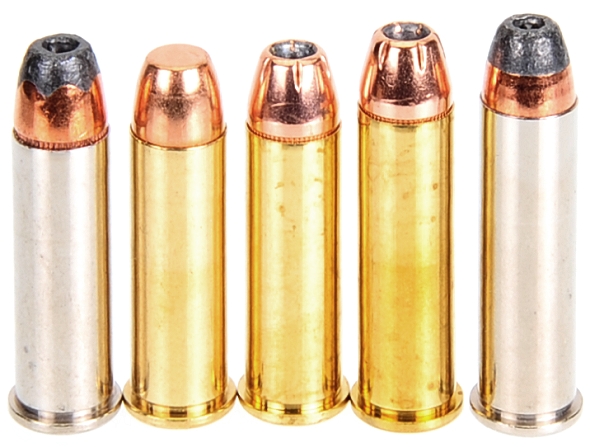
| Ammunition | Caliber | Bullet Type |
Bullet Weight Grains |
Rated FPS |
Actual FPS |
50 FT 3 Shot Group” |
| Remington High Terminal Performance +P | 38 Special | SJHP | 110 | 950 | 962 | 1.0 |
| Winchester Target | 38 Special | FMJ | 130 | 800 | 817 | 0.8 |
| Hornady Custom | 38 Special | XTP | 158 | 800 | 715 | 1.2 |
| Hornady Custom | 357 Mag | XTP | 158 | 1250 | 1171 | 0.9 |
| Remington High Terminal Performance | 357 Mag | SJHP | 180 | 1145 | 1088 | 1.3 |
|
Groups shot from a Rest |
||||||
The S&W Model 686 SSR is an excellent 357 Mag revolver. It is relatively mild mannered, accurate and reliable. As an L frame, there is plenty of beef in the frame and cylinder to routinely handle 38 Special +P and 357 Mag ammunition. The balance and sight systems are right for just about everyone and the versatility of power based upon ammo selection give this revolver a great deal of flexibility. Nice revolver. If we can find some time we will work up a selection of handloads.
Smith & Wesson’s Model 686-6 357 Mag Part I
Smith & Wesson’s Model 686-6 357 Mag Part II

Email Notification